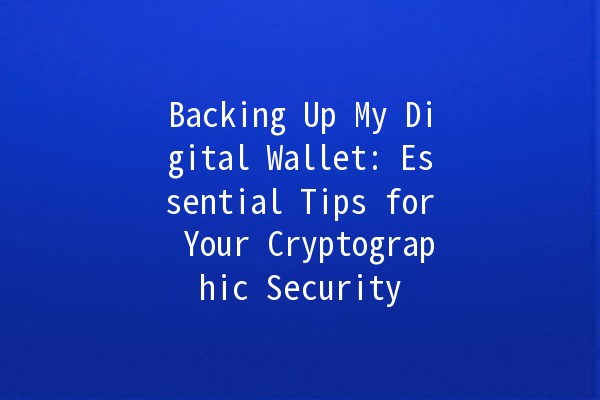




In an age where digital currencies and assets are becoming increasingly mainstream, ensuring the safety of your digital wallet is paramount. A digital wallet, whether it’s for storing cryptocurrencies or any form of digital asset, is a crucial tool for those navigating the evolving landscape of finance. In this article, we will explore practical tips to back up your digital wallet, boost your cybersecurity, and maintain peace of mind. You may find the following five productivityenhancing techniques particularly useful in mastering your digital wallet management.
Backing up your digital wallet is not just a precaution; it's a necessity. Digital wallets can be vulnerable to various risks, such as theft, loss of access, or technical failure. When you lose access to your wallet, the repercussions can be dire, including potentially losing your investments forever. Here’s why backing up your wallet is vital:

By implementing concrete backup strategies, you can effectively safeguard your digital assets. Below are five highly effective techniques to enhance your backup strategy.
A hardware wallet, such as Trezor or Ledger, is a physical device designed to securely store your cryptocurrency keys offline. Using a hardware wallet provides an additional layer of security against online threats.
Purchase a Hardware Wallet: Begin by purchasing a reputable hardware wallet.
Transfer Your Assets: Follow the manufacturer's guidelines to transfer your digital assets from your software wallet to your hardware wallet.
Store It Safely: Keep the device in a secure location to prevent theft or damage.
By utilizing a hardware wallet, you ensure that even if your computer is compromised, your digital assets remain safe.
A paper wallet involves generating a QR code that represents your wallet’s public and private keys, then printing it out on paper. This method keeps your keys offline and out of reach from hackers.
Generate a Paper Wallet: Use a trusted service like bitaddress.org. Make sure to follow their best practices for ensuring security during the generation process.
Print and Store: Print the wallet securely and store it in a safe place, such as a safety deposit box, to prevent loss or damage.
Test the Wallet: Optionally, transfer a small amount of cryptocurrency to test the functionality of your paper wallet.
Paper wallets offer a great way to secure your assets, especially if you prefer keeping everything offline.
Just as you update your software, regularly updating your backup methods ensures you are protected against new vulnerabilities and threats.
Schedule Regular Backups: Set a schedule—monthly or quarterly—to update your backup methods.
Use Trusted Software: Ensure any software used for backups is uptodate and from a reliable source.
Verify Backup Integrity: After updates, verify that all backups can access your digital assets without issues.
Staying proactive with backup updates will help mitigate potential risks that arise from outdated security measures.
The strength of your digital wallet backup is only as strong as your overall security practices. Implementing robust security measures is essential to protect your assets.
Use TwoFactor Authentication (2FA): Enable 2FA on all accounts associated with your digital wallet for added security.
Create Complex Passwords: Use a password manager to create strong, unique passwords for your accounts.
Frequent Security Audits: Periodically review your security practices to identify any potential vulnerability.
By fortifying your security protocols, you create a multilayered defense for your digital wallet.
The digital currency landscape is always evolving. Staying informed about new technologies, threats, and backup techniques is key to maintaining your digital wallet’s security.
Follow Relevant Blogs: Subscribe to reputable cryptocurrency blogs and forums where experts share insights and updates.
Join Online Communities: Participate in online communities (like Reddit or Discord groups focused on cryptocurrencies) to learn from others’ experiences.
Attend Workshops or Webinars: Consider attending workshops and webinars on cryptocurrency security to deepen your understanding.
Educating yourself keeps you aware of the latest trends and threats, ensuring you are always prepared.
There are primarily two types of digital wallets: hot wallets and cold wallets. Hot wallets are online wallets that are easily accessible but more susceptible to hacking. Cold wallets, such as hardware or paper wallets, store your keys offline, providing a higher level of security.
When choosing a hardware wallet, consider the following factors: the wallet's compatibility with your preferred cryptocurrencies, the security features it offers, the reputation of the manufacturer, and user reviews. Look for wallets that have a strong track record and regular security updates.
Using a cloud backup for your wallet can be risky. Although it offers convenience, it also exposes your private keys to potential breaches. If you choose this method, ensure that the cloud service employs strong encryption and twofactor authentication.
It is advisable to back up your digital wallet regularly—at least every few months or after significant transactions. Establishing a backup routine ensures you have uptodate copies of your wallet data.
Recovery of a digital wallet depends on how well you've backed it up. If you have kept secure backups (like hardware wallets or paper wallets), you should be able to recover access to your assets. However, without any backups or recovery phrases, it may be impossible to regain access.
If you suspect that your wallet has been compromised, act quickly! Move your assets to a new wallet immediately and change passwords for associated accounts. Review your security practices to identify and mend any vulnerabilities.
Backing up your digital wallet is not merely a formality; it is an essential practice that protects your assets in a digital world fraught with risks. By implementing the aforementioned techniques and staying informed, you can secure your wallet and navigate the cryptocurrency landscape with confidence.